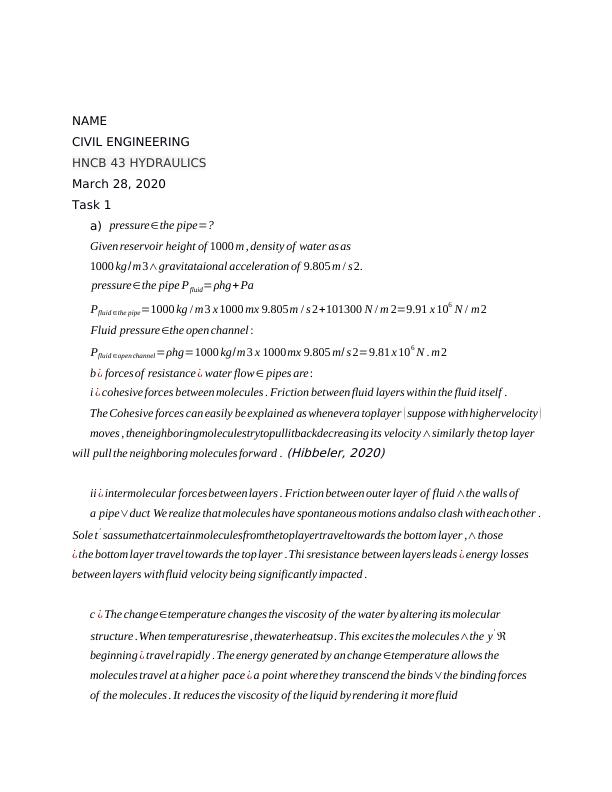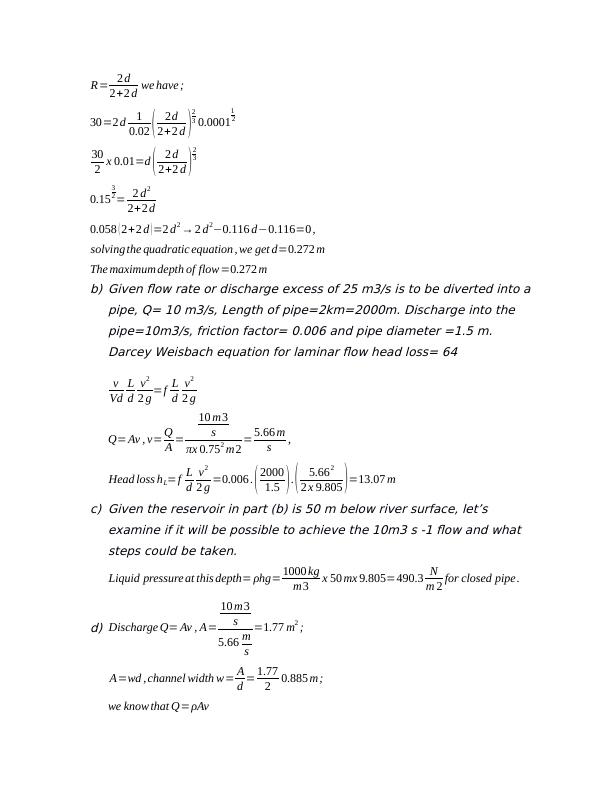NAME CIVIL ENGINEERING HNCB 43 HYDRAULICS
Added on 2022-08-20
9 Pages701 Words14 Views
NAME
CIVIL ENGINEERING
HNCB 43 HYDRAULICS
March 28, 2020
Task 1
a) pressure∈the pipe=?
Given reservoir height of 1000 m , density of water as as
1000 kg /m3∧gravitataional acceleration of 9.805 m / s 2.
pressure∈the pipe Pfluid=ρhg+ Pa
Pfluid ∈the pipe=1000 kg / m3 x 1000 mx 9.805m / s 2+101300 N / m 2=9.91 x 106 N / m2
Fluid pressure∈the open channel :
Pfluid ∈open channel=ρhg=1000 kg/m3 x 1000mx 9.805 m/ s 2=9.81 x 106 N . m2
b ¿ forces of resistance ¿ water flow∈ pipes are:
i ¿ cohesive forces between molecules . Friction between fluid layers within the fluid itself .
The Cohesive forces can easily be explained as whenevera toplayer ( suppose with highervelocity )
moves , theneighboringmoleculestrytopullitbackdecreasing its velocity∧similarly thetop layer
will pull the neighboring molecules forward .
(Hibbeler, 2020)
ii ¿ intermolecular forces between layers . Friction between outer layer of fluid ∧the walls of
a pipe∨duct We realize that molecules have spontaneous motions andalso clash witheach other .
Solet' sassumethatcertainmoleculesfromthetoplayertraveltowards the bottom layer ,∧those
¿ the bottom layer travel towards the toplayer .Thi sresistance between layersleads ¿ energy losses
between layers with fluid velocity being significantly impacted .
c ¿ The change∈temperature changes the viscosity of the water by altering its molecular
structure .When temperaturesrise , thewaterheatsup . This excites the molecules∧the y' ℜ
beginning ¿ travel rapidly . The energy generated by an change ∈temperature allows the
molecules travel at a higher pace ¿ a point where they transcend the binds∨the binding forces
of the molecules . It reduces the viscosity of the liquid by rendering it more fluid
CIVIL ENGINEERING
HNCB 43 HYDRAULICS
March 28, 2020
Task 1
a) pressure∈the pipe=?
Given reservoir height of 1000 m , density of water as as
1000 kg /m3∧gravitataional acceleration of 9.805 m / s 2.
pressure∈the pipe Pfluid=ρhg+ Pa
Pfluid ∈the pipe=1000 kg / m3 x 1000 mx 9.805m / s 2+101300 N / m 2=9.91 x 106 N / m2
Fluid pressure∈the open channel :
Pfluid ∈open channel=ρhg=1000 kg/m3 x 1000mx 9.805 m/ s 2=9.81 x 106 N . m2
b ¿ forces of resistance ¿ water flow∈ pipes are:
i ¿ cohesive forces between molecules . Friction between fluid layers within the fluid itself .
The Cohesive forces can easily be explained as whenevera toplayer ( suppose with highervelocity )
moves , theneighboringmoleculestrytopullitbackdecreasing its velocity∧similarly thetop layer
will pull the neighboring molecules forward .
(Hibbeler, 2020)
ii ¿ intermolecular forces between layers . Friction between outer layer of fluid ∧the walls of
a pipe∨duct We realize that molecules have spontaneous motions andalso clash witheach other .
Solet' sassumethatcertainmoleculesfromthetoplayertraveltowards the bottom layer ,∧those
¿ the bottom layer travel towards the toplayer .Thi sresistance between layersleads ¿ energy losses
between layers with fluid velocity being significantly impacted .
c ¿ The change∈temperature changes the viscosity of the water by altering its molecular
structure .When temperaturesrise , thewaterheatsup . This excites the molecules∧the y' ℜ
beginning ¿ travel rapidly . The energy generated by an change ∈temperature allows the
molecules travel at a higher pace ¿ a point where they transcend the binds∨the binding forces
of the molecules . It reduces the viscosity of the liquid by rendering it more fluid

(Horritt , Bates , Fewtrell , Mason ,∧Wilson, 2012).
d ¿ Laminar flow : the flow of the fluid where each particule of the fluid obeys a smooth path ,
pathsthat never interfere witheach other . Another consequence of thelaminar flow isthat the
fluid velocity remains unchanged at every point∈the fluid (¿ , 2017).
However ,∈Turbulent flow :erratic flow , defined by tiny whirlpool areas .The velocity of this
fluid is obviously not constant at any point .
e ¿The Reynolds number is theratio of inertial forces ¿ viscous forces ∧isa metric for
determining whether the fluid islaminar∨turbulent . Whenever the inertial forces are stronger
overtheviscousforces ( asthefluidmovesquickerandRebecomeslarger ) , sotheflowis
turbulent . If the Reynolds number is greater than3500 ,the flow is turbulent .f) Boundary layer is the region where the fluid changes from zero velocity
at the wall to a peak in the main stream of the flow. Surface roughness
triggers the change to turbulence in the boundary layer at all Reynolds
numbers, contributing to early separation due to decreased drag and
momentum deficit.
g ¿
Connect pipes in parallel to increases the area and reduced pipe
lengths hence reduced resistance. Secondly, adopt smoother pipes and
smoother finish of open channel surfaces. Also, reduce constrictions,
bends along the pipes or open channels that would cause resistance
development in such sections.
h ¿ Include additional pipe capacity ¿ deal with unforeseen increase ∈demand∧water outages .
The solutiontransitions ¿ a single objective optimization task (minimizing costs)¿ a multi−objective optimizatio
Task 2
a ¿ Given Q= 30 m3
s , channel width=2 m, Manning constant n=0.02
Q= AV ∧v= 1
n R
2
3 S
1
2 Such that Q= A 1
n R
2
3 S
1
2
where A=Channel widthx depth ,
lets denote depth as d hence Q= ( wxd ) 1
n R
2
3 S
1
2 ,
substituting the variables∧assuming a slope s of 0.0001 , hydraulic radius
d ¿ Laminar flow : the flow of the fluid where each particule of the fluid obeys a smooth path ,
pathsthat never interfere witheach other . Another consequence of thelaminar flow isthat the
fluid velocity remains unchanged at every point∈the fluid (¿ , 2017).
However ,∈Turbulent flow :erratic flow , defined by tiny whirlpool areas .The velocity of this
fluid is obviously not constant at any point .
e ¿The Reynolds number is theratio of inertial forces ¿ viscous forces ∧isa metric for
determining whether the fluid islaminar∨turbulent . Whenever the inertial forces are stronger
overtheviscousforces ( asthefluidmovesquickerandRebecomeslarger ) , sotheflowis
turbulent . If the Reynolds number is greater than3500 ,the flow is turbulent .f) Boundary layer is the region where the fluid changes from zero velocity
at the wall to a peak in the main stream of the flow. Surface roughness
triggers the change to turbulence in the boundary layer at all Reynolds
numbers, contributing to early separation due to decreased drag and
momentum deficit.
g ¿
Connect pipes in parallel to increases the area and reduced pipe
lengths hence reduced resistance. Secondly, adopt smoother pipes and
smoother finish of open channel surfaces. Also, reduce constrictions,
bends along the pipes or open channels that would cause resistance
development in such sections.
h ¿ Include additional pipe capacity ¿ deal with unforeseen increase ∈demand∧water outages .
The solutiontransitions ¿ a single objective optimization task (minimizing costs)¿ a multi−objective optimizatio
Task 2
a ¿ Given Q= 30 m3
s , channel width=2 m, Manning constant n=0.02
Q= AV ∧v= 1
n R
2
3 S
1
2 Such that Q= A 1
n R
2
3 S
1
2
where A=Channel widthx depth ,
lets denote depth as d hence Q= ( wxd ) 1
n R
2
3 S
1
2 ,
substituting the variables∧assuming a slope s of 0.0001 , hydraulic radius

R= 2 d
2+2 d we have ;
30=2 d 1
0.02 ( 2d
2+2 d )2
3 0.0001
1
2
30
2 x 0.01=d ( 2 d
2+2 d )2
3
0.15
3
2 = 2 d2
2+2 d
0.058 ( 2+2 d )=2 d2 → 2 d2−0.116 d−0.116=0 ,
solving the quadratic equation , we get d=0.272 m
The maximum depth of flow =0.272 m
b) Given flow rate or discharge excess of 25 m3/s is to be diverted into a
pipe, Q= 10 m3/s, Length of pipe=2km=2000m. Discharge into the
pipe=10m3/s, friction factor= 0.006 and pipe diameter =1.5 m.
Darcey Weisbach equation for laminar flow head loss= 64
v
Vd
L
d
v2
2 g =f L
d
v2
2 g
Q= Av , v= Q
A =
10 m3
s
πx 0.752 m2 = 5.66 m
s ,
Head loss hL=f L
d
v2
2 g =0.006 . ( 2000
1.5 ). ( 5.662
2 x 9.805 )=13.07 mc) Given the reservoir in part (b) is 50 m below river surface, let’s
examine if it will be possible to achieve the 10m3 s -1 flow and what
steps could be taken.
Liquid pressure at this depth= ρhg= 1000 kg
m3 x 50 mx 9.805=490.3 N
m 2 for closed pipe.
d) Discharge Q= Av , A=
10 m3
s
5.66 m
s
=1.77 m2 ;
A=wd , channel width w= A
d = 1.77
2 0.885 m;
we know that Q=ρAv
2+2 d we have ;
30=2 d 1
0.02 ( 2d
2+2 d )2
3 0.0001
1
2
30
2 x 0.01=d ( 2 d
2+2 d )2
3
0.15
3
2 = 2 d2
2+2 d
0.058 ( 2+2 d )=2 d2 → 2 d2−0.116 d−0.116=0 ,
solving the quadratic equation , we get d=0.272 m
The maximum depth of flow =0.272 m
b) Given flow rate or discharge excess of 25 m3/s is to be diverted into a
pipe, Q= 10 m3/s, Length of pipe=2km=2000m. Discharge into the
pipe=10m3/s, friction factor= 0.006 and pipe diameter =1.5 m.
Darcey Weisbach equation for laminar flow head loss= 64
v
Vd
L
d
v2
2 g =f L
d
v2
2 g
Q= Av , v= Q
A =
10 m3
s
πx 0.752 m2 = 5.66 m
s ,
Head loss hL=f L
d
v2
2 g =0.006 . ( 2000
1.5 ). ( 5.662
2 x 9.805 )=13.07 mc) Given the reservoir in part (b) is 50 m below river surface, let’s
examine if it will be possible to achieve the 10m3 s -1 flow and what
steps could be taken.
Liquid pressure at this depth= ρhg= 1000 kg
m3 x 50 mx 9.805=490.3 N
m 2 for closed pipe.
d) Discharge Q= Av , A=
10 m3
s
5.66 m
s
=1.77 m2 ;
A=wd , channel width w= A
d = 1.77
2 0.885 m;
we know that Q=ρAv

End of preview
Want to access all the pages? Upload your documents or become a member.
